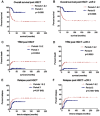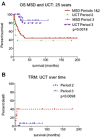Transplant-related mortality following allogeneic hematopoeitic stem cell transplantation for pediatric acute lymphoblastic leukemia: 25-year retrospective review
- PMID: 23733511
- PMCID: PMC3798104
- DOI: 10.1002/pbc.24559
Transplant-related mortality following allogeneic hematopoeitic stem cell transplantation for pediatric acute lymphoblastic leukemia: 25-year retrospective review
Abstract
Background: Over the last 25 years, donor source, conditioning, graft-versus-host disease prevention and supportive care for children undergoing hematopoeitic stem cell transplantation (HSCT) have changed dramatically. HSCT indications for acute lymphoblastic leukemia (ALL) now include high-risk patients in first and subsequent remission. There is a large burden of infectious and pre-HSCT morbidities, due to myelosuppressive therapy required for remission induction. We hypothesized that, despite these trends, overall survival (OS) had increased.
Procedure: A retrospective audit of allogeneic pediatric HSCT for ALL was performed in our institution over 25 years. Outcomes for 136 HSCTs were analyzed in three consecutive 8-year periods (Period 1: 1/1/1984-31/8/1992, Period 2: 1/9/1992-30/4/2001, Period 3: 1/5/2001-31/12/2009).
Results: Despite a significant increase in unrelated donor HSCT, event-free and OS over 25 years improved significantly. (EFS 31.6-64.8%, P = 0.0027; OS 41.8-78.9%, P < 0.0001) Concurrently, TRM dropped from 33% to 5% (P = 0.0004) whilst relapse rate was static (P = 0.07). TRM reduced significantly for matched sibling and unrelated cord blood transplantation (UCT) in Period 3 compared with earlier periods (P = 0.036, P = 0.0098, respectively). Factors leading to improved survival in patients undergoing UCT include better matching, higher total nucleated cell doses, and significantly faster neutrophil engraftment. Length of initial HSCT admission was similar over time.
Conclusion: EFS and OS have increased significantly despite heightened HSCT complexity. This survival gain was due to TRM reduction. Contemporary patients have benefited from refined donor selection and improved supportive care. Overall rates of leukemic relapse post-HSCT are unchanged, and remain the focus for improvement.
Keywords: hematopoeitic stem cell transplant; lymphoblastic leukemia; outcomes; pediatric acute survival; transplant-related mortality.
Copyright © 2013 Wiley Periodicals, Inc.
Figures


References
-
- Hunger S, Raetz E, Loh M, et al. Improving outcomes for high-risk ALL: Translating new discoveries into clinical care. Pediatr Blood Cancer. 2011;56:984–993. - PubMed
-
- Pulsipher M, Bader P, Klingebiel T, et al. Allogeneic transplantation for pediatric acute lymphoblastic leukemia: The emerging role of peritransplantation minimal residual disease chimerism monitoring and novel chemotherapeutic molecular, and immune approaches aimed at preventing relapse. Biol Blood Marrow Transplant. 2009;15:62–71. - PubMed
-
- Bader P, Kreyenberg H, Henze G, et al. Prognostic value of minimal residual disease quantification before allogeneic stem-cell transplantation in relapsed childhood acute lymphoblastic leukemia; The ALL-REZ BFM Study Group. J Clin Oncol. 2009;27:377–384. - PubMed
Publication types
MeSH terms
LinkOut - more resources
Full Text Sources
Other Literature Sources
Medical

